

The go-bag – CogSciSci. Here, the #CogSciSci community has brought together a whole bunch of blogs, articles and research to help you answer the question “Why are you doing that?”
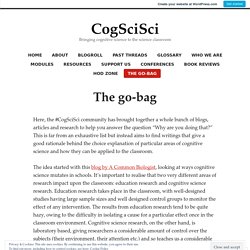
This is far from an exhaustive list but instead aims to find writings that give a good rationale behind the choice explanation of particular areas of cognitive science and how they can be applied to the classroom. The idea started with this blog by A Common Biologist, looking at ways cognitive science mutates in schools. It’s important to realise that two very different areas of research impact upon the classroom: education research and cognitive science research. Education research takes place in the classroom, with well-designed studies having large sample sizes and well designed control groups to monitor the effect of any intervention. The results from education research tend to be quite hazy, owing to the difficulty in isolating a cause for a particular effect once in the classroom environment.
Dispelling the Myth: Training in Education or Neuroscience Decreases but Does Not Eliminate Beliefs in Neuromyths. Introduction Educational neuroscience (also known as mind, brain, education science) is an emerging field that draws attention to the potential practical implications of neuroscience research for educational contexts.
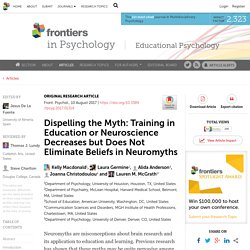
This new field represents the intersection of education with neuroscience and the cognitive and developmental sciences, among other fields, in order to develop evidence-based recommendations for teaching and learning (Fischer et al., 2010). This emerging field has garnered growing interest (i.e., Gabrieli, 2009; Carew and Magsamen, 2010; Sigman et al., 2014), but it is also widely recognized that attempts to create cross-disciplinary links between education and neuroscience may create opportunities for misunderstanding and miscommunication (Bruer, 1997; Goswami, 2006; Bowers, 2016).
To date, the largest study of educators (N = 1,200) was conducted in the UK by the Wellcome Trust using an online survey of neuromyths (Simmonds, 2014). Methods Participants. Recognition versus recall. How working memory affects teaching and what you can do about it. Many psychologists accept variations on a model of the mind that consists of a limited ‘working’ or ‘short-term’ memory and an effectively limitless ‘long-term’ memory.
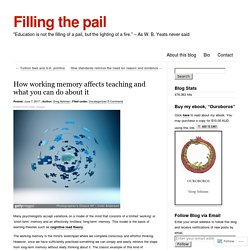
This model is the basis of learning theories such as cognitive load theory. The working memory is the mind’s sketchpad where we complete conscious and effortful thinking. Learning strategies: a synthesis and conceptual model. Far transfer to language and math of a short software-based gaming intervention. Author Affiliations Edited* by Michael I.

Posner, University of Oregon, Eugene, OR, and approved March 12, 2014 (received for review October 28, 2013) Significance Executive functions (EF) imply processes critical for purposeful, goal-directed behavior. In children, evidence derived from laboratory measures indicates that training can improve EF. Abstract. Memorizing: Faster, Easier, Longer Lasting, and More Fun. gMARCH17. Kindling Your Child’s Enthusiasm for School. Brain-Based Strategies to Reduce Test Stress. Improving working memory capacity. The science of resilience: how to teach students to persevere. In schools today, the focus is not only on helping students pass exams, but also on improving their character by making them more resilient.
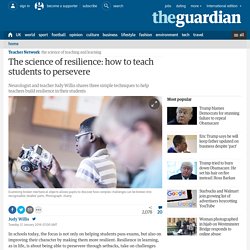
Brain Development and Adolescent Growth Spurts. As your students move through adolescence, their brains are going through a dynamic change from chaos to clarity.
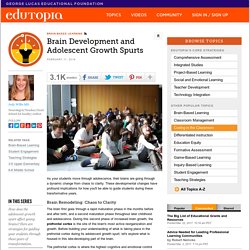
These developmental changes have profound implications for how you'll be able to guide students during these transformative years. Brain Remodeling: Chaos to Clarity The brain first goes through a rapid maturation phase in the months before and after birth, and a second maturation phase throughout later childhood and adolescence. During this second phase of increased brain growth, the prefrontal cortex is the site of the brain's most active reorganization and growth. Before building your understanding of what is taking place in the prefrontal cortex during its adolescent growth spurt, let's explore what is housed in this late-developing part of the brain.
The prefrontal cortex is where the highest cognitive and emotional control networks are being constructed, especially during the school years. These networks do not reach full effectiveness until early adulthood. Prioritizing: A Critical Executive Function. The executive function of prioritizing guides two types of tasks.
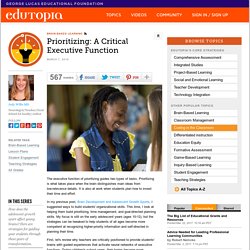
Prioritizing is what takes place when the brain distinguishes main ideas from low-relevance details. It is also at work when students plan how to invest their time and effort. Edutopia. Building Students' Cognitive Flexibility. Conquering the Multitasking Brain Drain. With the increasing surge of information and the compelling distractions of social media, videos, and games at their fingertips, students are understandably drawn to engage with these distractions during homework.
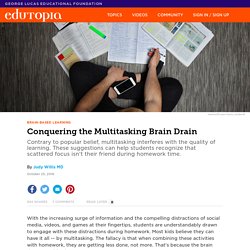
Most kids believe they can have it all -- by multitasking. The fallacy is that when combining these activities with homework, they are getting less done, not more. That's because the brain doesn't multitask. Teachers, parents, and students all suffer from brain-draining inefficiency when the focus on homework is disrupted by multitasking. Consequences such as inadequate sleep, languishing on the next day's learning, or late and low-quality assignments push parents and teachers into unpleasant roles as nags, helicopters, and rule-enforcers.
Learning Myths And Realities From Brain Science : NPR Ed. This blog post has some pretty useful information.
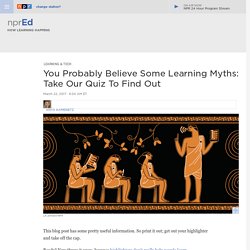
So print it out; get out your highlighter and take off the cap. Ready? Defining the Skills for Success. We know that strong executive function (EF) is key to children’s success in school and in life, but that term has become a kitchen sink for all sorts of self-regulatory skills.

Are attention shifting and cognitive flexibility the most important core skills, or mindfulness and self-control? What about working memory and goal-setting? Emotion regulation and creativity? Without clear definitions, it can be difficult to pinpoint which skills students are lacking — and to create and assess programs that build those skills. Executive Function vs. The Brain as explained by John Cleese. Teen Brain HD. Driving or Talking? The Brain Concentrates on One Thing at a Time – Neuroscience News. Summary: A new study investigates what happens when we multitask and why it’s not such a good idea to drive and use a phone at the same time. Source: Linköping University. When we are busy with something that requires the use of sight, the brain reduces hearing to make it easy for us.
This is the conclusion of a study conducted by researchers from Linköping University in collaboration with others. The results give researchers a deeper understanding of what happens in the brain when we concentrate on something. Neuromyths in Education: Prevalence and Predictors of Misconceptions among Teachers. Introduction There is widespread interest among teachers in the application of neuroscientific research findings in educational practice. Neuroscientific research has received a lot of attention since 1990–2000, which was declared the “Decade of the Brain” in the United States. Yet, the field of neuroscience is complex and the accurate transfer of research findings to the classroom is often difficult (Jolles et al., 2005; Devonshire and Dommett, 2010; Ansari et al., 2011).
Students are not hard-wired to learn in different ways – we need to stop using unproven, harmful methods. In our series, Better Teachers, we’ll explore how to improve teacher education in Australia. We’ll look at what the evidence says on a range of themes including how to raise the status of the profession and measure and improve teacher quality. In health there are well-established protocols that govern the introduction of any new drug or treatment. Of major consideration is the notion of doing no harm. In education there are no such controls and plenty of vested interests keen to see the adoption of new strategies and resources for a variety of ideological and financial reasons. Teachers need to be critical consumers of research – as with medicine, lives are also at stake – yet with the best will in the world and without the knowledge and time to do so, decisions may be made to adopt new approaches that are not only ineffectual, but can actually do harm.
Scans reveal how teenage brain develops BBC News. WorkingMemoryProcessingSpeedClassroom. Poor Processing Speed - Free Resources - Psych4Schools. Processing speed relates to an individual’s ability to perform simple repetitive cognitive tasks quickly and automatically. Issues with processing speed only become evident once a person knows how to perform a task, rather than during the initial learning phase. This is because poor processing speed relates to a reduced ability to automatically or fluently perform learnt tasks. Poor Processing Speed - Free Resources - Psych4Schools. Global BrainED Neuroscience for the Learner web3.
Social and Emotional Learning - InspirED. Papers - Science of Learning Research Centre. Multitaskingtest.net. Genes to Cognition Online. Education team. Wellcome uses cookies. Read our policy. Education Endowment Foundation. Centre for Educational Neuroscience. Teachers and parents have a great enthusiasm for the brain sciences and the light they can shed on children’s and adults’ learning in educational environments. Inside the Brain. Home - TTA. Neuromyths in Education: Prevalence and Predictors of Misconceptions among Teachers.